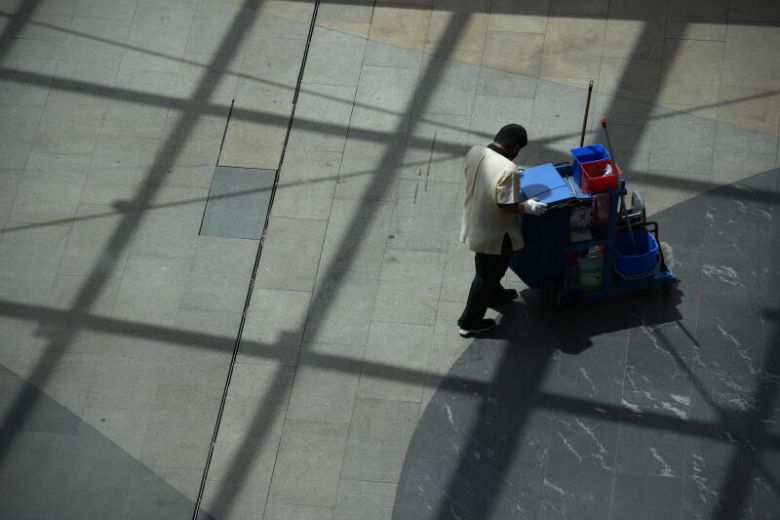Parliament: Highest qualification for 4 in 5 of 30,000 S'porean low-wage workers is post-secondary level or lower, says Zaqy
Sign up now: Get ST's newsletters delivered to your inbox

More than a third of these Singaporean workers are aged 50 and above.
ST PHOTO: NG SOR LUAN
Follow topic:
SINGAPORE - There are about 30,000 Singaporean low-wage workers and the highest educational qualification for four in five of them is post-secondary level or lower, said Senior Minister of State for Manpower Zaqy Mohamadin Parliament on Tuesday (Nov 3).
For about half of these workers - largely employed in roles such as office clerks, food and beverage workers, cleaners and shop salesmen - the highest level is secondary education or lower, he added.
More than a third of these Singaporean workers are aged 50 and above, and this reflects a profile of workers who have less access to higher education and could be at higher risk of being unemployed, he said.
Mr Zaqy was responding to a question from Mr Liang Eng Hwa (Bukit Panjang), who asked for the profiles of workers that earn not more than $1,300 monthly.
A third of this group of workers are youth aged between 15 to 24, who are in "vacation jobs", he said.
Earlier, Mr Zaqy said there are about 30,000 full-time employees and 22,000 self-employed persons that receive less than that amount, in response to a question filed by Associate Professor Jamus Lim (Sengkang GRC).
In addition, Mr Zaqy said about half of these 30,000 Singaporeans live in households with household per capita income of more than $1,300, which suggests they are not the primary breadwinners for their families and have other means of support.
As for what is being done to help this group of workers, Mr Zaqy said besides Workfare Income Supplement payouts, they will continue to be supported by the Workfare Skills Support Scheme, which provides training allowance for selected courses and a cash reward for completing training.
Doing so enables them to upskill and earn higher wages, he said, adding that other schemes are also available for their daily and medical needs, such as ComCare, GST vouchers and Silver Support.
In Parliament last month, deputy labour chief Koh Poh Koon said about 32,000 full-time workers in Singapore - or 1.7 per cent of the local workforce - take home less than $1,300 each month.
Mr Zaqy on Tuesday said those numbers were based on residential statistics, and Prof Lim had asked for the number of Singaporeans.
Mr Zaqy said the Workfare Income Supplement remains a key pillar of social security for Singaporean lower-wage workers.
"Studies have consistently shown that Workfare has been effective in motivating less-educated Singaporeans, particularly those in the older age groups, to enter and stay in the workforce," he said.
This is important as workforce participation is key to supplementing their household incomes and ability to save for retirement, he added.
Prof Lim had asked for the number of Singaporeans earning not more than $1,300 a month in take-home pay, excluding employer and employee Central Provident Fund (CPF) contributions, as well as other deductions of income.
Mr Zaqy said the International Labour Organisation's (ILO) definition of earnings include contributions of employees to social security and pension schemes.
Singapore's approach is broadly aligned with the ILO, and considers personal income to include CPF contributions and Workfare Income Supplement (WIS) payouts because these can be used for necessities, including healthcare and housing, he said.
The Workfare Income Supplement, introduced in 2007, is among government measures implemented over the last decade to raise low-income workers' pay.
From 2007 to last year, more than $6.8 billion has been given out to 890,000 lower-wage workers, said Mr Zaqy.
In the past three years, an average of about 400,000 people receive Workfare each year, he said. The average payout received annually in the same period was about $1,560, while the maximum was $3,600.
About half or 49 per cent of all Workfare recipients are aged 60 and above.
Another 18 per cent are aged 55 to 59, and 21 per cent are aged 45 to 54.
About 11 per cent are aged 35 to 44.
In a follow-up question, Ms Carrie Tan (Nee Soon GRC) asked if the age criterion - set at a minimum age of 35 - to qualify for WIS would be revised if the worker is the sole breadwinner for his family.
She also asked if such payouts could be increased so that "instead of a family having to go to multiple agencies to receive different kinds of social security benefits, they can get this increased ability in terms of financial resources very directly through WIS".
Mr Zaqy replied that significant adjustments have been made to the WIS since it was introduced, including in January this year (2020).
While he understood Ms Tan's concerns, he suggested that WIS is targeted at older workers, with about half of the recipients aged 60 and above.
He said: "Because the younger workers have got the potential - they are more educated, more skills upgrading opportunities, for example - and therefore there's the potential which we want to help them through."
For those who are single parents or have other family issues, other government schemes are available, said Mr Zaqy, such as ComCare or financial assistance schemes in schools.

